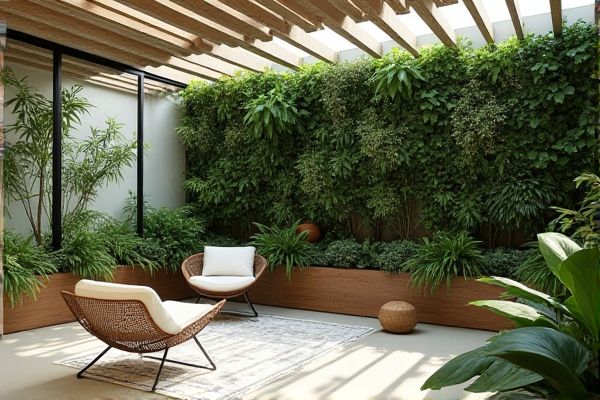
Vertical gardens maximize limited space by growing plants upward on walls or trellises, making them ideal for small terraces or urban areas. Explore the rest of this article to discover which garden type suits your space and lifestyle best.
Table of Comparison
| Feature | Vertical Garden | Horizontal Garden (Terrace) |
|---|---|---|
| Space Utilization | Maximizes limited vertical space; ideal for small areas | Requires ample horizontal space; uses flat surfaces like terraces |
| Plant Types | Suitable for climbing plants, herbs, succulents | Supports a wide range including vegetables, flowers, shrubs |
| Watering | Often needs drip irrigation to prevent overwatering | Natural drainage; easier manual watering possible |
| Installation Complexity | Requires structural support and specialized planters | Simple soil beds or containers; less structural demands |
| Maintenance | Needs regular pruning; monitoring for drainage issues | Standard garden care; easier access for maintenance |
| Sunlight Exposure | Vertical orientation may limit sunlight on some plants | Flat exposure provides uniform sunlight distribution |
| Aesthetic Appeal | Modern, space-saving green walls; enhances vertical surfaces | Traditional garden look; can accommodate diverse layouts |
| Cost | Higher initial setup due to materials and support | Generally lower cost; depends on terrace condition |
Introduction to Vertical and Horizontal Gardens
Vertical gardens maximize limited spaces by growing plants upward on walls or structures, ideal for urban environments with minimal floor area. Horizontal gardens, commonly found on terraces, allow for traditional soil planting over a flat surface, providing more room for root expansion and diverse plant varieties. Choosing between vertical and horizontal gardens depends on your available space, sunlight exposure, and the types of plants you wish to cultivate.
Core Differences: Vertical vs Horizontal Gardens
Vertical gardens maximize limited space by growing plants upward using walls or structures, ideal for small terraces and urban environments. Horizontal gardens spread plants across flat surfaces like terrace floors, offering more room for diverse plant varieties and easier maintenance. Your choice depends on space availability, aesthetic preference, and gardening goals.
Space Efficiency: Maximizing Your Terrace
Vertical gardens maximize terrace space by utilizing upward surfaces, allowing for more plants in compact areas compared to traditional horizontal gardens. This method enhances air circulation and sunlight exposure for each plant, promoting healthier growth within limited square footage. Terrace vertical gardens also reduce soil use and simplify maintenance, making them ideal for urban environments with constrained outdoor areas.
Design and Aesthetics Comparison
Vertical gardens maximize space by utilizing walls or vertical structures, creating a striking, green facade that enhances urban aesthetics and adds texture to limited areas. Horizontal terrace gardens offer expansive layouts that allow for diverse plant arrangements, providing a lush, open-air environment ideal for relaxation and outdoor living. Your choice between vertical and horizontal designs should consider spatial constraints and the desired visual impact in your garden.
Plant Selection: Suitability for Each Method
Vertical gardens favor lightweight, drought-tolerant plants like succulents, ferns, and herbs that thrive in limited soil and require minimal root space. Horizontal gardens on terraces accommodate a wider variety of plants, including larger shrubs, vegetables, and flowering perennials that need deeper soil and more sunlight. Plant selection depends on factors such as available space, irrigation, and structural support, with vertical gardens benefiting from compact, adaptable species and horizontal gardens supporting diverse, larger crops.
Installation and Maintenance Requirements
Vertical gardens require specialized mounting systems and irrigation setups to support plant growth on walls, making installation more complex than horizontal gardens on terraces, which primarily involve soil beds or containers. Maintenance of vertical gardens often demands regular monitoring of water distribution and structural stability, while terrace gardens need consistent soil care, drainage management, and potential pest control due to open exposure. Your choice should consider the ease of access and available space, as vertical gardens save ground area but may increase upkeep complexity compared to horizontal terrace gardens.
Light, Airflow, and Microclimate Factors
Vertical gardens maximize light exposure by using upward surfaces, making them ideal for limited spaces with moderate sunlight, while horizontal terrace gardens benefit from unobstructed natural light but may require strategic shading. Airflow is enhanced in vertical setups through elevated plant arrangements that prevent stagnation, whereas horizontal gardens rely on open spaces to promote ventilation but can experience more heat retention. Your choice should consider microclimate effects: vertical gardens create cooler, shaded zones and reduce heat islands, while horizontal gardens absorb more heat and maintain steadier moisture levels.
Cost Analysis: Investment and Long-term Value
Vertical gardens generally require a higher initial investment due to specialized structures and irrigation systems, while horizontal terrace gardens involve costs related to soil preparation and space utilization. Over time, vertical gardens offer long-term value by maximizing limited space and potentially reducing water usage, whereas terrace gardens provide greater crop variety and easier maintenance but may incur higher ongoing expenses. Your choice depends on balancing upfront costs with sustainable benefits tailored to your available space and gardening goals.
Sustainability and Environmental Impact
Vertical gardens significantly enhance sustainability by maximizing green space in urban areas, improving air quality, and reducing the urban heat island effect through increased vegetation coverage. Horizontal terrace gardens promote biodiversity and support local ecosystems by providing habitat for pollinators and natural water filtration, but they require more soil and water resources compared to vertical gardens. Both garden types contribute to carbon sequestration and energy savings, with vertical gardens often offering higher efficiency in water usage and space conservation.
Choosing the Right Garden Style for Your Terrace
Vertical gardens maximize limited terrace space by utilizing walls or structures, making them ideal for small areas and urban settings. Horizontal gardens offer expansive planting beds that support a wider variety of plants and provide easy access for maintenance. Evaluating your terrace size, sunlight exposure, and plant preferences will help you choose the right garden style to enhance Your outdoor living space efficiently.
 homyna.com
homyna.com